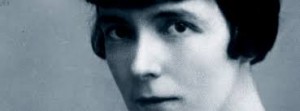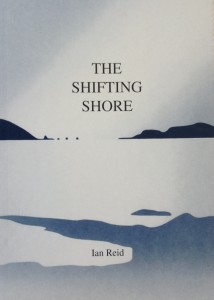Someone has asked me about the header image (above) that I’ve chosen for my website. Although it looks abstract, it does represent in stylised silhouette a specific place: the meeting of land and sea at Wellington Heads, the harbour entrance near where I was born in New Zealand. This image is an enlarged detail from the cover of my book of poems The Shifting Shore, taken from a screen print by Wellington artist Malcolm Warr with his kind permission.
I like the blurriness of those looming shapes, suggesting the deceptive weather and sombre light often found there at the edge of Cook Strait, where from time to time even big ships come to grief. One of my earliest memories is of being taken as a small boy by my father to a hilltop above our home in Island Bay to look down at the Wanganella, a liner from Sydney that had gone aground on a reef at the harbour entrance and remained stuck there with its 400 passengers for more than a fortnight before being refloated. Years later the larger and more hapless Wahine struck same reef in a ferocious storm and 51 people drowned.
Wellington’s most famous writer, Katherine Mansfield, evoked its harbour scenes in several of her stories, such as ‘The Voyage’ –
Silently the dark wharf began to slip, to slide, to edge away from them… The strip of water grew broader, darker…
– and ‘When the Wind Blows’:
A big black steamer with a long loop of smoke streaming, with the portholes lighted, with lights everywhere, is putting out to sea. The wind does not stop her; she cuts through the waves, making for the open gate between the pointed rocks that leads to…
Mansfield also wrote memorably about quieter inlets and beaches enclosed within Wellington harbour. In a chapter of my book Narrative Exchanges I’ve analysed the opening passage of her story ‘At the Bay’, drawing attention to the way it accentuates misty indistinctness, obscuring the margin between sea and land and the margin between domesticated areas and the surrounding bush. Here’s how it begins:
Very early morning. The sun was not yet risen, and the whole of Crescent Bay was hidden under a white sea-mist. The big bush-covered hills at the back were smothered. You could not see where they ended and the paddocks and bungalows began. The sandy road was gone…there was nothing to mark which was the beach and where was the sea.
In large measure At the Bay is a story about the blurring of boundaries, the unreliability of natural and social demarcation lines. Its imagery is infused with a strong sense that coast-dwellers (almost all New Zealanders live near the coast) have only an insecure temporary footing in their landscape.
I’m reminded of an eloquent sonnet by Charles Brasch (founding editor of the premier NZ literary magazine Landfall) called ‘The Islands’, which begins: ‘Always, in these islands, meeting and parting / Shake us, making tremulous the salt-rimmed air…’ The poem ends like this: ‘Remindingly beside the quays, the white / Ships lie smoking; and from their haunted bay / The godwits vanish towards another summer. / Everywhere in light and calm the murmuring / Shadow of departure; distance looks our way / And none knows where he will lie down at night.’
I wish those lines were my own invention. But I’ve written other lines that try to express similar feelings, and they’re in this book:

